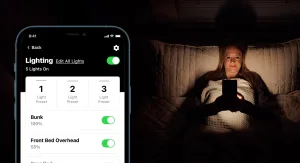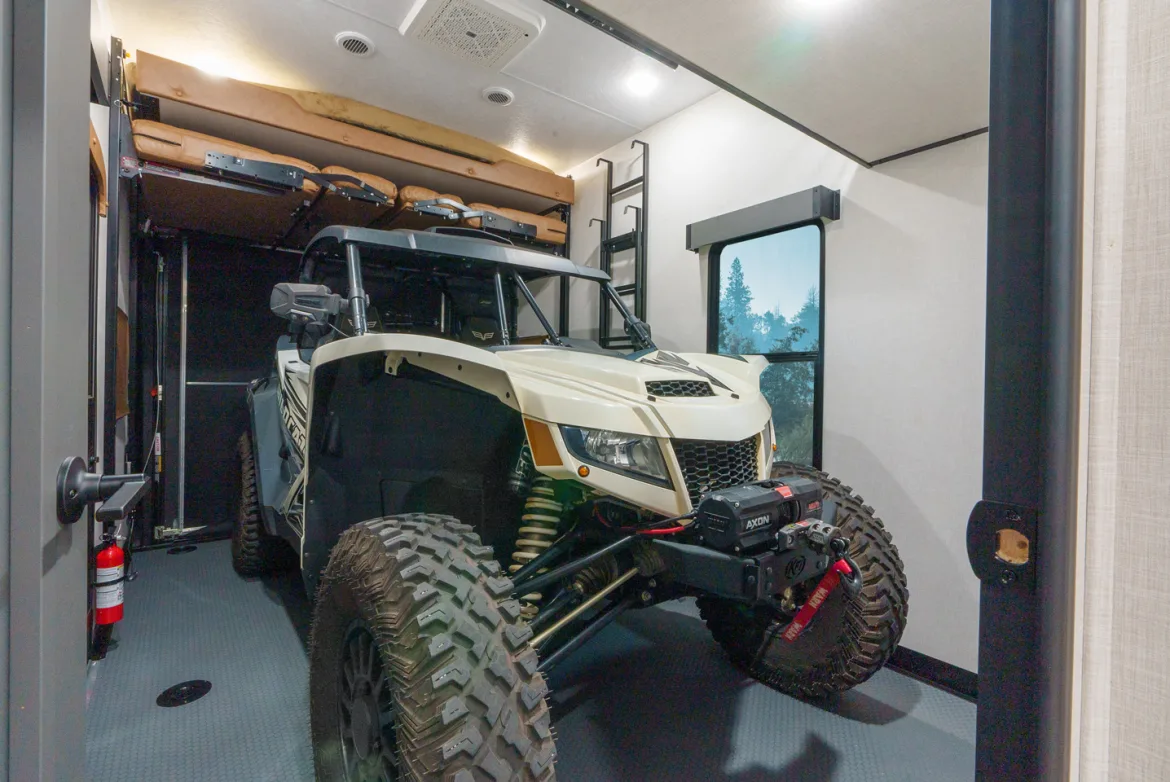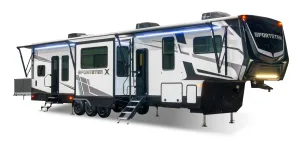KZ RV Unveils Reimagined Toy Hauler
KZ Recreational Vehicles announced the launch of the all-new Sportster X Toy Hauler line of fifth-wheels and travel trailers, calling it “a complete reimagination of what a toy hauler can be.” Formerly known as the Sportster, the new Sportster X is designed to meet the needs of today’s adventurers. A company press release noted that every aspect of this brand has been rethought, focusing on superior craftsmanship, leading innovation, and affordability.
The Sportster X is said to be “the ultimate toy hauler” for those with larger UTVs, providing garages that range from 11 feet to 15 feet, and built to accommodate both the length and weight of the largest toys on the market. The redesign began at the chassis and continued to the roof, resulting in a modern look that elevates form and function. Storage was a top priority, and the new units feature triple-entry pass-through storage areas that are outfitted with a felt-lined finish, powder-coated storage shelves, LED light strips, and slam latch cargo doors.
The Sportster X offers features such as a ramp door patio railing kit, rear awning, collapsible exterior roof ladder, and power awning(s) equipped with LED light strips. Its advanced climate package makes the vehicle suitable for all-season use. An insulated, heated, and enclosed underbelly extends through the garage, providing year-round comfort in a variety of climates. Inside, the Sportster X includes accent lighting that creates a warm, inviting ambience. A JBL audio system delivers premium sound both inside and out.
The Sportster X comes with KZ’s 2-year hitch-to-bumper warranty. For more information, visit kz-rv.com.
Winnebago Introduces Smart Technology

Winnebago Connect software can be programmed by the user to customize a wide range of RV functions, such as lighting, climate control, locks, water systems, awnings, and energy usage.
Winnebago recently launched Winnebago Connect, a smart technology platform that marks the brand’s first custom software development effort. The innovative new technology proactively monitors and controls all on-board RV systems according to user preferences and is said to be the only product on the RV market that achieves this integration through a single platform.
The technology features a range of customizable capabilities, from programmable lighting and climate control to cabin door locks and water system use. Through smart energy optimization, Winnebago Connect will notify users via the main dashboard and the Winnebago App if issues arise with any onboard systems so they can quickly address them.
A key factor of the technology is that it works proactively. For example, if the temperature inside the RV exceeds a preset parameter, it will open vents to let in fresh air before activating the air conditioner. It will even retract awnings when a wind sensor detects windy conditions. Owners gain the added conveniences of remote and self-diagnostics, plus over-the-air software updates, to ensure they always have the tools and resources necessary for a great RV experience.
Winnebago Connect will debut in the all-new Winnebago View and Navion 24T floor plans before integrating into the entire Winnebago lineup over the next few years. The platform includes free and paid subscription offerings.
To learn more, visit winnebago.com/technology/winnebago-connect.
National Parks Contribute to U.S. Economy, Jobs
The U.S. National Park Service released a new report in August 2024 that indicated visitor spending in communities near national parks resulted in a record-high $55.6 billion benefit to the nation’s economy in 2023 and supported 415,400 jobs.
The report, 2023 National Park Visitor Spending Effects, finds that 325.5 million visitors spent $26.4 billion in communities near national parks. This spending supported 415,400 jobs, provided $19.4 billion in labor income, and added $55.6 billion in economic output to the U.S. economy. The lodging sector had the highest direct contributions, with $9.9 billion in economic output and 89,200 jobs. Restaurants received the next greatest direct contributions, with $5.2 billion in economic output and 68,600 jobs.
The latest report reflects improved socioeconomic survey data, enhancing the accuracy of spending estimates, and helps the National Park Service learn more about park visitors. To view the report, visit nps.gov/subjects/socialscience/vse.htm.
Restrictions on Motorhome Sales in Certain States?
The following information has been reported by the Recreation Vehicle Industry Association. For more information and ongoing updates, visit rvia.org/news-insights/californias-ban-motorhomes-what-you-need-know.
In 2025, California’s Advanced Clean Trucks (ACT) regulation, aimed at promoting zero-emission vehicles (ZEVs), will create a near-total “ban” on motorhome sales in the state, as well as in additional states that follow the California Air Resource Board (CARB) regulations. While the regulation does not specifically ban motorhome sales, the ACT regulation mandates manufacturers of medium- and heavy-duty vehicles to sell an increasing percentage of ZEVs each year. This has led chassis manufacturers to halt sales of traditional internal combustion engine chassis for motorhomes in California, stemming from the lack of ZEV chassis suitable for motorhomes.
Since 2020, the RV Industry Association has been working with CARB on the ACT regulations, including conversations with CARB staff and written and oral testimony at public hearings. When CARB filed its proposed amendments in 2024, RV industry officials met with CARB staff to discuss the impact on the industry. The association also submitted comments laying out the negative impact of the regulation on the motorhome industry.
Unfortunately, CARB did not make any further amendment that would alleviate the issue of motorhome manufacturers being told by chassis manufacturers that they would not be able to supply ICE (internal combustion engine) chassis for sale into California, since they could not offset their ZEV deficits by sales of a ZEV motorhome chassis.
In addition to ACT, other regulations passed in the last several years — the Omnibus Low NOx rule and the Advanced Clean Fleets rule — will work to gradually transition medium- and heavy-duty vehicles to zero-emission vehicles (ZEVs) by 2036. Another, the Small Off-Road Engine regulation, impacts spark-ignition engines on generators.
While the RV Industry Association continues to work with manufacturers, dealers, and CARB staff to find a solution, if nothing changes, motorhomes will not be able to be sold and registered in California beginning in 2025. The exact date is still to be determined.
Following are several key points about ACT and how it specifically impacts the RV industry and RV consumers both in California and in other states.
The ACT regulation isn’t a direct ban on the sale of motorhomes in California, but it has as its primary component a sales requirement that applies to manufacturers that certify incomplete chassis or complete vehicles greater than 8,500 pounds GVWR. Manufacturers including Daimler, Ford, GM, Mercedes-Benz, Navistar, Stellantis, etc., are required to sell ZEVs as a percentage of their annual total sales. Because chassis manufacturers have no ZEV chassis that are rated for applications to motorhomes, they have been informing motorhome manufacturers that they will not be able to provide them with any internal combustion engine chassis for motorhomes for the California market.
The ACT regulation is not limited to California. RV Industry Association notes that 10 states have adopted the CARB ACT rule. Rules in Massachusetts, New Jersey, New York, Oregon, and Washington will take effect with the 2025 model year; rules in Vermont as of the 2026 model year; and those in Colorado, Maryland, New Mexico, and Rhode Island with the 2027 model year. States that adopt California emission standards (so-called Section 177 states) are required by federal law to maintain consistency with California’s requirements. Thus, amendments made in California will eventually be adopted by those states.
While attention thus far has focused primarily on Class A and Class C diesel motorhomes, the regulation, with a few exceptions, applies to all medium-duty or heavy-duty vehicles with combustion engines. Any non-exempted on-road vehicle over 8,500 pounds GVWR is covered by the regulation, including Class B motorhomes, most of which have a GVWR over that amount.
The ACT rule applies to model-year 2024 and later chassis. The rule has no effect on motorhomes that have already been legally produced and delivered to California.
If a consumer buys an RV from another state that does not comply with ACT, will the consumer be able to register the RV in California? CARB officials have said that a used vehicle, defined as one with more than 7,500 miles on the odometer, could be brought in and registered. Any motorhome with less than 7,500 miles would be considered a new vehicle and would have to be compliant to be registered.
According to CARB, California RV dealers can sell a non-compliant motorhome to a resident of another state provided the customer intends to register the motorhome in a non-ACT state.


